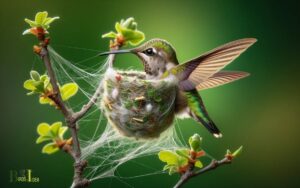What Type of Hummingbirds Live in the Rainforest? Woodnymph!
Rainforests are home to a variety of hummingbird species, including the Violet-crowned Woodnymph, Booted Racket-tail, Long-tailed Sylph, and the Andean Emerald. Each species adapts to its unique niche within the rainforest ecosystem.
Hummingbirds found in rainforests have adapted to the diverse array of flowers present. These birds are crucial for pollination and display a wide range of colors and features that help them survive in the dense forest environment.
Some examples of adaptations include specialized beak shapes for extracting nectar from specific flower types and agile flight patterns to maneuver through the thick foliage.
Here are some notable rainforest hummingbird species:
Discover the breathtaking diversity of hummingbirds in the rainforest, where each flutter and splash of color reveals the intricate web of life.

Key Takeaway
The Diversity of Rainforest Hummingbirds
The rainforest’s hummingbird diversity showcases a remarkable array of species and adaptations. With over 300 species, the rainforest is a hotspot for hummingbird diversity.
These tiny birds have evolved to occupy various niches within the ecosystem, leading to a wide range of sizes, colors, and beak shapes.
For example, the sword-billed hummingbird has a beak longer than its body, allowing it to feed on the nectar of long tubular flowers that other hummingbirds cannot access.
In contrast, the bee hummingbird is the smallest bird in the world, weighing less than a penny.
The diversity of rainforest hummingbirds also extends to their behaviors, with some species being highly territorial while others engage in lekking behavior.
This rich variety of hummingbirds contributes to the rainforest’s ecological complexity and serves as a fascinating subject for scientific study.
Unique Characteristics of Rainforest Hummingbirds
Rainforest hummingbirds exhibit a remarkable diversity of physical characteristics and specialized behaviors.
Their unique adaptations for nectar feeding, including specialized bills and long, extendable tongues, allow them to thrive in the complex and competitive rainforest environment.
Additionally, their vibrant plumage and intricate courtship displays make them an intriguing subject for researchers and bird enthusiasts alike.
Rainforest Hummingbird Diversity
Exploring the diversity of hummingbirds in the rainforest reveals their unique characteristics and adaptations to this rich and complex ecosystem.
Rainforest hummingbirds display a remarkable variety of colors, beak shapes, and feeding behaviors, making them a fascinating subject of study.
Below is a table showcasing some of the diverse hummingbird species found in the rainforest:
| Hummingbird Species | Unique Characteristic |
|---|---|
| Ruby-throated | Iridescent red throat patch |
| Long-billed Hermit | Extraordinarily long bill |
| Fiery-throated | Brilliant metallic plumage |
These unique characteristics allow rainforest hummingbirds to thrive in their specific niches within the dense vegetation, utilizing their specialized features to access nectar from various flower types and compete for resources.
Understanding the diversity and adaptations of rainforest hummingbirds provides valuable insights into the intricate web of life within this biodiverse ecosystem.
Specialized Nectar Feeding
Hummingbirds in the rainforest exhibit specialized nectar feeding behaviors, which enable them to efficiently extract nectar from a diverse array of flowers, thereby securing their place within the intricate web of life in this biodiverse ecosystem.
These remarkable birds have co-evolved with the rainforest flora, developing unique physical and behavioral adaptations.
Their long, slender bills and extendable, tubular tongues allow them to reach deep into flowers to access nectar, while their rapid wingbeats enable them to hover in front of blossoms with remarkable precision.
Some rainforest hummingbirds have even developed specialized beak shapes to access particular flower types, showcasing the incredible diversity of nectar-feeding strategies within this habitat.
These specialized nectar feeding behaviors not only sustain the hummingbirds but also play a crucial role in pollination, contributing to the rainforest’s rich tapestry of life.
Colorful Species of Rainforest Hummingbirds
Native to the lush canopies of the rainforest, the colorful species of hummingbirds exhibit a dazzling array of vibrant hues and iridescent plumage. These stunning creatures captivate observers with their remarkable beauty and behavior.
Here are four reasons why the colorful species of rainforest hummingbirds evoke such a strong emotional response:
- Vibrant Plumage: Their feathers boast an astonishing spectrum of colors, including vivid greens, blues, reds, and purples, creating a mesmerizing display as they flit through the verdant foliage.
- Graceful Flight: The agile and acrobatic aerial displays of these hummingbirds, as they hover and dart with precision, evoke a sense of wonder and awe.
- Distinctive Courtship Rituals: Their elaborate and enchanting courtship displays, involving intricate movements and calls, inspire feelings of romance and admiration.
- Symbolism and Cultural Significance: In various cultures, these radiant birds symbolize joy, love, and vitality, adding a layer of emotional resonance to their already captivating presence.
Feeding Behaviors of Rainforest Hummingbirds
The feeding behaviors of rainforest hummingbirds revolve around their utilization of nectar, insects, and small spiders as primary food sources.
Hummingbirds have developed specialized beaks and long, extendible, straw-like tongues to extract nectar from flowers.
This feeding adaptation allows them to reach deep into tubular-shaped flowers to access the sugary liquid inside.
In addition to nectar, hummingbirds also consume insects and small spiders, which provide essential proteins and fats necessary for their survival. They catch these prey items by using their impressive agility and speed during flight.
The consumption of insects and spiders also supplements their diet with nutrients that may be lacking in nectar alone.
This diverse feeding behavior allows rainforest hummingbirds to thrive in their habitat by efficiently extracting energy from various sources.
Nesting Habits of Rainforest Hummingbirds
Hummingbirds in the rainforest exhibit diverse nesting habits, with each species showcasing unique behaviors and preferences.
Nest building is a meticulous process, with birds carefully selecting and arranging materials such as moss, lichen, spider silk, and plant down to create secure and camouflaged structures.
Some species opt for natural materials, while others incorporate human-made objects, showcasing the adaptability and resourcefulness of rainforest hummingbirds in their nesting practices.
Rainforest Hummingbird Nesting
Several species of hummingbirds in the rainforest exhibit diverse nesting habits, reflecting their adaptation to the unique ecological conditions of this environment.
These tiny birds, despite their size, display remarkable nesting behaviors that are both fascinating and essential for their survival.
Here are some observations of rainforest hummingbird nesting habits:
- Nest Placement: Hummingbirds in the rainforest often place their nests in sheltered locations, such as on the underside of leaves or in the forks of branches, providing protection from the elements and potential predators.
- Nest Construction: Intricately weaving together plant fibers, moss, and lichens, rainforest hummingbirds create sturdy, camouflaged nests that blend seamlessly into their surroundings.
- Incubation: The female hummingbird diligently tends to her eggs, providing warmth and protection as she incubates them until they hatch.
- Parental Care: Both parents actively participate in feeding and caring for the hatchlings, ensuring their healthy growth and development.
These behaviors showcase the resourcefulness and adaptability of rainforest hummingbirds in nesting and raising their young.
Nest Building and Materials
Rainforest hummingbirds’ meticulous nest building and material selection reflect their adaptability and resourcefulness in creating secure environments for their offspring.
These tiny birds construct their nests using a variety of materials, including plant fibers, mosses, lichens, and spider silk, which are meticulously woven together. The use of spider silk provides elasticity, allowing the nest to expand as the chicks grow.
Additionally, the incorporation of mosses and lichens not only camouflages the nest but also provides insulation and moisture regulation.
Some species decorate the exterior of their nests with bits of leaves, bark, and flowers, further concealing them from predators.
Threats to Rainforest Hummingbird Populations
The survival of rainforest hummingbird populations is threatened by habitat loss, deforestation, and climate change.
These factors have led to a concerning decline in their numbers, putting these beautiful creatures at risk of extinction.
The following list highlights the devastating impacts of these threats:
- Loss of nesting sites and food sources leading to decreased reproductive success.
- Disruption of migration patterns, affecting breeding and foraging opportunities.
- Increased competition for limited resources, leading to food scarcity and heightened vulnerability to predators.
- Exposure to extreme weather events, resulting in population stress and decreased survival rates.
These challenges underscore the urgent need for conservation efforts to protect rainforest hummingbirds and their delicate ecosystems.
By understanding these threats, we can work towards implementing effective strategies to safeguard their future.
Conservation Efforts for Rainforest Hummingbirds
Efforts to conserve rainforest hummingbirds are crucial in mitigating the threats posed by habitat loss, deforestation, and climate change.
Conservation initiatives include preserving and restoring their natural habitats, establishing protected areas, and promoting sustainable land use practices.
Furthermore, raising awareness about the importance of rainforest ecosystems and the role of hummingbirds within them is essential for garnering public support.
Collaborative research projects are also underway to better understand the specific needs and behaviors of different hummingbird species, enabling targeted conservation strategies.
Additionally, international cooperation is vital, as many hummingbird species migrate across borders, necessitating coordinated conservation efforts.
Encouraging ecotourism that supports local communities while minimizing disturbances to hummingbird habitats can also contribute to their conservation.
Ultimately, a multi-faceted approach, integrating scientific research, policy, education, and community engagement, is essential for the long-term survival of rainforest hummingbirds.
Conclusion
The rainforest is home to a diverse array of hummingbird species, each with unique characteristics and colorful plumage.
These birds exhibit fascinating feeding behaviors and nesting habits, but unfortunately, they face threats to their populations.
Conservation efforts are crucial to protect these beautiful and important creatures. Without action, the vibrant and delicate balance of the rainforest ecosystem could be at risk.






